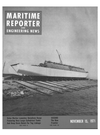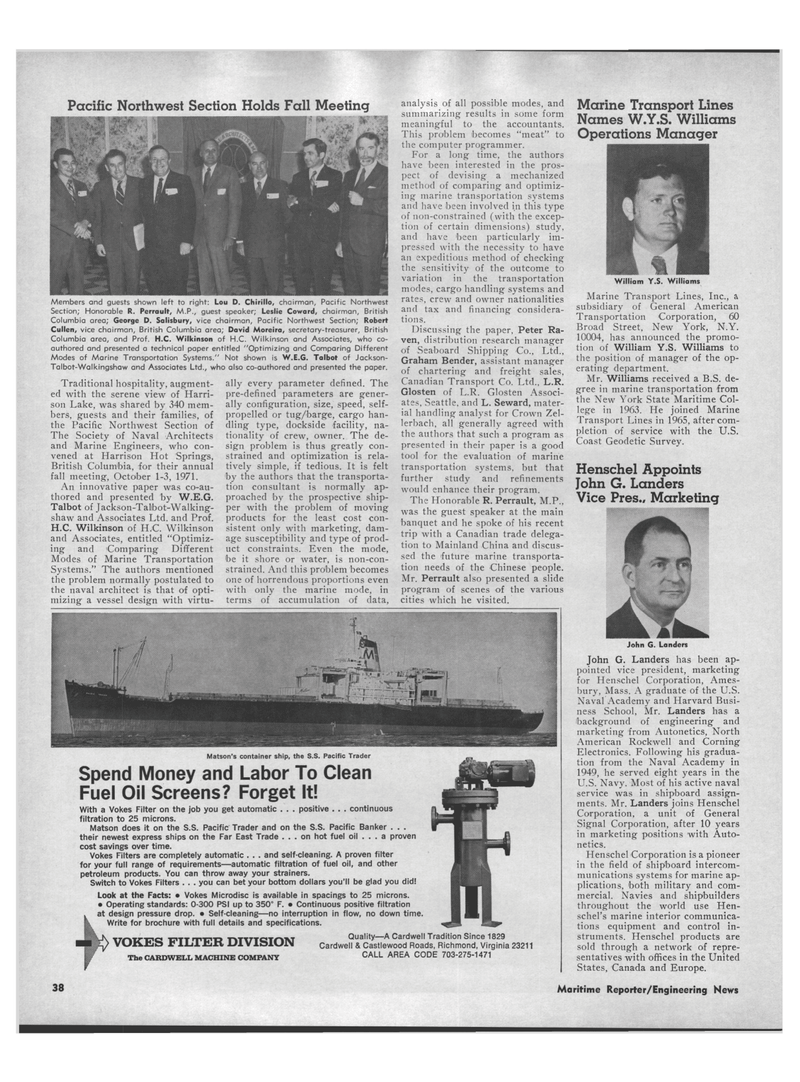
Page 36: of Maritime Reporter Magazine (November 15, 1971)
Read this page in Pdf, Flash or Html5 edition of November 15, 1971 Maritime Reporter Magazine
Pacific Northwest Section Holds Fall Meeting
Members and guests shown left to right: Lou D. Chirillo, chairman, Pacific Northwest
Section; Honorable R. Perrault, M.P., guest speaker; Leslie Coward, chairman, British
Columbia area; George D. Salisbury, vice chairman, Pacific Northwest Section; Robert
Cullen, vice chairman, British Columbia area; David Moreira, secretary-treasurer, British
Columbia area, and Prof. H.C. Wilkinson of H.C. Wilkinson and Associates, who co- authored and presented a technical paper entitled "Optimizing and Comparing Different
Modes of Marine Transportation Systems." Not shown is W.E.G. Talbot of Jackson-
Talbot-Walkingshaw and Associates Ltd., who also co-authored and presented the paper.
Traditional hospitality, augment- ed with the serene view of Harri- son Lake, was shared by 340 mem- bers, guests and their families, of the Pacific Northwest Section of
The Society of Naval Architects and Marine Engineers, who con- vened at Harrison Hot Springs,
British Columbia, for their annual fall meeting, October 1-3, 1971.
An innovative paper was co-au- thored and presented by W.E.G.
Talbot of Jackson-Talfoot-Walking- shaw and Associates Ltd. and Prof.
H.C. Wilkinson of H.C. Wilkinson and Associates, entitled "Optimiz- ing and Comparing Different
Modes of Marine Transportation
Systems." The authors mentioned the problem normally postulated to the naval architect is that of opti- mizing a vessel design with virtu- ally every parameter defined. The pre-defined parameters are gener- ally configuration, size, speed, self- propelled or tug/barge, cargo han- dling type, dockside facility, na- tionality of crew, owner. The de- sign problem is thus greatly con- strained and optimization is rela- tively simple, if tedious. It is felt by the authors that the transporta- tion consultant is normally ap- proached by the prospective ship- per with the problem of moving products for the least cost con- sistent only with marketing, dam- age susceptibility and type of prod- uct constraints. Even the mode, be it shore or water, is non-con- strained. And this problem becomes one of horrendous proportions even with only the marine mode, in terms of accumulation of data, analysis of all possible modes, and summarizing results in some form meaningful to the accountants.
This problem becomes "meat" to the computer programmer.
For a long time, the authors have been interested in the pros- pect of devising a mechanized method of comparing and optimiz- ing marine transportation systems and have been involved in this type of non-constrained (with the excep- tion of certain dimensions) study, and have been particularly im- pressed with the necessity to have an expeditious method of checking the sensitivity of the outcome to variation in the transportation modes, cargo handling systems and rates, crew and owner nationalities and tax and financing considera- tions.
Discussing the paper, Peter Ra- ven, distribution research manager of Seaboard Shipping Co., Ltd.,
Graham Bender, assistant manager of chartering and freight sales,
Canadian Transport Co. Ltd., L.R.
Glosten of L.R. Glosten Associ- ates, Seattle, and L. Seward, mater- ial handling analyst for Crown Zel- lerbach, all generally agreed with the authors that such a program as presented in their paper is a good tool for the evaluation of marine transportation systems, but that further study and refinements would enhance their program.
The Honorable R. Perrault, M.P., was the guest speaker at the main banquet and he spoke of his recent trip with a Canadian trade delega- tion to Mainland China and discus- sed the future marine transporta- tion needs of the Chinese people.
Mr. Perrault also presented a slide program of scenes of the various cities which he visited.
Marine Transport Lines
Names W.Y.S. Williams
Operations Manager
William Y.S. Williams
Marine Transport Lines, Inc., a subsidiary of General American
Transportation Corporation, 60
Broad Street, New York, N.Y. 10004, has announced the promo- tion of William Y.S. Williams to the position of manager of the op- erating department.
Mr. Williams received a B.S. de- gree in marine transportation from the New York State Maritime Col- lege in 1963. He joined Marine
Transport Lines in 1965, after com- pletion of service with the U.S.
Coast Geodetic Survey.
Henschel Appoints
John G. Landers
Vice Pres., Marketing
John G. Landers
John G. Landers has been ap- pointed vice president, marketing for Henschel Corporation, Ames- bury, Mass. A graduate of the U.S.
Naval Academy and Harvard Busi- ness School, Mr. Landers has a background of engineering and marketing from Autonetics, North
American Rockwell and Corning
Electronics. Following his gradua- tion from the Naval Academy in 1949, he served eight years in the
U.S. Navy. Most of his active naval service was in shipboard assign- ments. Mr. Landers joins Henschel
Corporation, a unit of General
Signal Corporation, after 10 years in marketing positions with Auto- netics.
Henschel Corporation is a pioneer in the field of shipboard intercom- munications systems for marine ap- plications, both military and com- mercial. Navies and shipbuilders throughout the world use Hen- schel's marine interior communica- tions equipment and control in- struments. Henschel products are sold through a network of repre- sentatives with offices in the United
States, Canada and Europe.
Matson's container ship, the S.S. Pacific Trader
Spend Money and Labor To Clean
Fuel Oil Screens? Forget It!
With a Vokes Filter on the job you get automatic . . . positive . . . continuous filtration to 25 microns.
Matson does it on the S.S. Pacific Trader and on the S.S. Pacific Banker . . . their newest express ships on the Far East Trade ... on hot fuel oil ... a proven cost savings over time.
Vokes Filters are completely automatic . . . and self-cleaning. A proven filter for your full range of requirements—automatic filtration of fuel oil, and other petroleum products. You can throw away your strainers.
Switch to Vokes Filters . . . you can bet your bottom dollars you'll be glad you did!
Look at the Facts: • Vokes Microdisc is available in spacings to 25 microns. • Operating standards: 0-300 PSI up to 350° F. • Continuous positive filtration at design pressure drop. • Self-cleaning—no interruption in flow, no down time.
Write for brochure with full details and specifications. ¥
VOKES FILTER DIVISION
The CARDWELL MACHINE COMPANY
Quality—A Cardwell Tradition Since 1829
Cardwell & Castlewood Roads, Richmond, Virginia 23211
CALL AREA CODE 703-275-1471 38 Maritime Reporter/Engineering News

 35
35

 37
37
